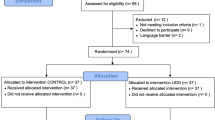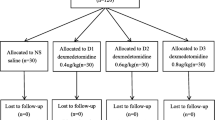Abstract
Purpose
To evaluate the haemodynamic and respiratory changes during laparoscopic cholecystectomy in elderly ASA III patients.
Methods
This clinical descriptive study included 16 patients aged > 75 yr. Anaesthesia was induced with fentanyl and etomidate and maintained with N2O in O2 (50%), fentanyl and isoflurane as needed. Inspired minute volume was kept constant during anaesthesia. Cardiovascular monitoring included a radial artery catheter and a pulmonary artery catheter for measurement of CO, RVEF and S−vO2, and calculation of right ventricular end diastolic volume indexed (RVEDVI). Haemodynamic variables, arterial and venous blood gas analyses were collected before and 10 min after anaesthetic induction, 15, 30 and 60 min after insufflation (IAP = 12 mmHg) followed by a 10° headup till, and after exsufflation.
Results
The mean age was 81 ± 4 yr. The main cardiovascular depression was recorded after anaesthetic induction. Peritoneal insufflation resulted in improvement of cardiovas-cular function with increases in cardiac index (+19%), heart rate (+21%), MAP (+19%) and S−vO2 (+8%), (P < 0.05) which may be the result of a sympathetic stimulation. No change in preload (RVEDVI) and SVR was recorded. Cardiac index was unchanged during pneumoperitoneum. Laparoscopy was associated with an increase in PaCO2 15 min after CO2 insufflation (from 33.9 to 38.3 mmHg, P < 0.05) and a further elevation after 60 min (44,4 mmHg) without any sign of extra peritoneal diffusion. There was no change in the intrapulmonary shunt and the Pa-EtCO2 gradient remained stable (mean 7.2 mmHg).
Conclusion
We conclude that gradual abdominal insufflation to 12 mmHg followed by a limited 10° headup tilt is associated with cardiovascular stability in elderly ASA III patients.
Résumé
Objectif
Évaluer les altérations hémodynamiques et respiratoires survenant chez des patients âgés de classe ASA III pendant la chirurgie laparoscopique.
Méthodes
Cette étude descriptive incluait 16 patients âgés de plus de 75 ans. L’anesthésie était induite avec du fentanyl et de l’étomidate et entretenue avec un mélange O2/N2O (50%), et supplément de fentanyl et d’isoflurane selon les besoins. Le volume minute inspiré ne variait pas pendant l’anesthésie. Le monitorage cardiovasculaire comprenait un catheter radial et un cathéter artériel pulmonaire inséré afin de mesurer le DC, la fraction d’éjection du ventricule droit et la S−vO2; le volume télédiastolique du ventriculaire droit indexé (VTDVDI) était calculé. Les variables hémodynamiques, les analyses des gaz veineux et artériels ont été recueillies avant et dix min après l’induction, 15, 30 et 60 min après l’insufflation (12 mmHg) suivie d’une inclinaison de la table de 10° vers le haut, et à l’arrêt de l’insufflation.
Résultats
L’âge moyen était de 81 ± 4 ans. La dépression cardiovasculaire la plus importante survenait après l’induction de l’anesthésie. L’insufflation péritonéale améliorait la fonction cardiovasculaire en augmentant l’index cardiaque (+19%), la fréquence cardiaque (+21%), la PAM (+19%) et la S−vO2 (+8%), (P < 0,05), ce qui pourrait être dû à la stimulation sympathique. Aucun changement de la précharge (VTDVDI) et des RVS n’était noté. L’index cardiaque n’était pas modifié pendant le pneumopéritoine. La laparoscopie était associée à une augmentation de la PaCO2 15 min après l’insufflation de CO2 (de 33,9 à 38.3 mmHg, P < 0,05) et à une augmentation supplémentaire après 60 min (44,4 mmHg) sans manifestation de diffusion extrapéritonéale. Le shunt intrapulmonaire n’était pas modifié et le gradient Pa-EtCO2 demeurait stable (moyenne 7,2 mmHg).
Conclusion
Les auteurs concluent que l’insufflation abdominale graduelle jusqu’à 12 mmHg suivie d’une inclinaison vers le haut de la tête de la table de 10% est associée à la stabilité cardiovasculaire chez des patients âgés de classe ASA III.
Similar content being viewed by others
References
Joris J. Cigarini I, Legrand M, et al. Metabolic and respiratory changes after cholecystectomy performed via laparotomy or laparoscopy. Br J Anaesth 1992; 69: 341–5.
Rademaker BM, Ringers J, Odoom JA, de Wit LT, Kalkman CJ, Oosting J. Pulmonary function and stress response after laparoscopic cholecystectomy: comparison with subcostal incision and influence of thoracic epidural analgesia. Anesth Analg 1992; 75: 381–5.
Schauer PR, Luna J, Ghiatas AA, Glen ME, Warren JM, Sirinek KR. Pulmonary function after laparoscopic cholecystectomy. Surgery 1993; 114: 389–99.
Critchley LAH, Critchley JAJH, Gin T. Haemodynamic changes in patients undergoing laparoscopic cholecysteclomy: measurement by transthoracic electrical bioimpedance. Br J Anaesth 1993; 70: 681–3.
Cunningham AJ, Turner J, Rosenbaum S, Rafferty T. Trunsoesophageal echocardiographic assessment of haemodynamic function during laparoscopic cholecyslectomy. Br J Anaesth 1993; 70: 621–5.
Joris J, Honore P, Lamy M. Changes in oxygen transport and ventilation during laparoscopic cholecystectomy. Anesthesiology 1992; 77: A149.
Joris JL, Noirot DP, Legrand MJ, Jacquet NJ, Lamy ML. Hemodynamic changes during laparoscopic cholecystectomy. Anesth Analg 1993; 76: 1067–71.
Mc Laughlin JG, Bonnell BW, Scheeres DE, Dean RJ. The adverse hemodynamic effects related to laparoscopic cholecystectomy. Anesthesiology 1992; 77: A70.
Joris J, Ledoux D, Honore P, Lamy M. Ventilatory effects of CO2 insufflation during laparoscopic cholecystectomy. Anesthesiology 1991; 75: A121.
Muravchick S. Anesthesia for the elderly.In: Miller RD (Ed.). Anaesthesia, 3rd ed. New York: Churchill Livingstone Inc., 1990; 1969–83.
Fox LG, Hein HAT, Gawey BJ, Hellman CL, Ramsay MAE. Physiologic alterations during laparoscopic cholecystectomy in ASA III and IV patients. Anesthesiology 1993; 79: A55.
Feig BW. Berger DH, Dupuis JF, et al. Hemodynamic effects of CO2 abdominal insufflation (CAI) during laparoscopy in high-risk patients. Anesth Analg 1994; 78: S109.
Safran D, Sgambati S, Orlando R III. Laparoscopy in high-risk cardiac patients. Surg Gynecol Obstet 1993; 176: 548–54.
Gunnarsson L, Tokics L, Gustavsson H, Hedenstierna G. Influence of age on atelectasis formation and gas exchange impairment during general anaesthesia. Br J Anaesth 1991; 66: 423–32.
Ivankovich AD, Miletich DJ, Albrecht RF, Heyman HJ, Bonnet RF. Cardiovascular effects of intraperitoneal insufflation with carbon dioxide and nitrous oxide in the dog. Anesthesiology 1975; 42: 281–7.
Solis-Herruzo JA, Moreno D, Gonzalez A, et al. Effect of intrathoracic pressure on plasma arginine vasopressin levels. Gastroenterology 1991; 101: 607–17.
Wahba RWM, Mamazza J. Ventilatory requirements during laparoscopic cholecystectomy. Can J Anaesth 1993; 40: 206–10.
Wittgen CM, Andrus CH, Fitzgerald SD, Baudendistel LJ, Dahms TE, Kaminski DL. Analysis of the hemodynamic and ventilalory effects of laparoscopic cholecystectomy. Arch Surg 1991; 126: 997–1001.
Fitzgerald SD, Andrus CH, Baudendistel LJ, Dahms TE, Kaminski DL. Hypercarbia during carbon dioxide pneumoperitoneum. Am J Surg 1992; 163: 186–90.
Feig BW, Berger DH, Dougherty TB, et al. Pulmonary effects of CO2 abdominal insufflation (CAI) during laparoscopy in high-risk patients. Anesth Analg 1994; 78: S108.
Wittgen CM, Naunheim KS, Andrus CH, Kaminski DL. Preoperative pulmonary function evaluation for laparoscopic cholecystectomy. Arch Surg 1993; 128: 880–6.
Whitesell R, Asiddao C, Coliman D, Jablonski J. Relationship between arterial and peak expired carbon dioxide pressure during anesthesia and factors influencing the difference. Anesth Analg 1981; 60, 508–12.
Fletcher R, Jonson B. Deadspace and the single breath test for carbon dioxide during anaesthesia and artificial ventilation. Br J Anaesth 1984; 56: 109–19.
Author information
Authors and Affiliations
Rights and permissions
About this article
Cite this article
Dhoste, K., Lacoste, L., Karayan, J. et al. Haemodynamic and ventilatory changes during laparoscopic cholecystectomy in elderly ASA III patients. Can J Anaesth 43, 783–788 (1996). https://doi.org/10.1007/BF03013029
Accepted:
Published:
Issue Date:
DOI: https://doi.org/10.1007/BF03013029




